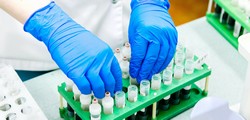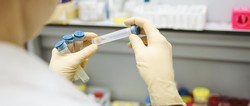The University has implemented a new pooled surveillance testing this spring semester to diminish the number of active COVID-19 cases on campus, according to Director of Health Services Kathy Maloney. This allows for testing more people with fewer resources, as per the Centers for Disease Control and Prevention (CDC).
Pooling surveillance testing involves mixing different samples into one bigger sample, or “pool,” and then testing this mixed sample using only one high-sensitivity test, according to the U.S. Food and Drug Administration (FDA). The benefits include testing more individuals with fewer resources and lower costs in groups of people where the prevalence of COVID-19 is low to obtain more accurate results.
“People will be separated into three zones; ‘Residential Students’, ‘Athletes’, and ‘All Others,’” said Maloney. Different pool samples will be taken from each zone frequently, with each pool containing 16 people. For athletes, the frequency of testing will be determined “by the Athletic Department in conjunction with NCAA and conference guidelines,” Maloney said. “50 percent of residential students will be tested each week and notified by the residence halls.”
Participation in this testing is also “a condition of residence,” according to Maloney. She said that all others, including students who have in-person classes and commuters, are strongly encouraged to participate and get tested together if they are in like-groups and off-campus houses. She further explained that costs of surveillance testing will be covered by the University, and only the “student’s health insurance will be billed by the laboratory” for additional individual testing if one was in a pool that tested positive as well as symptomatic testing.
“The pool testing self-service was quick and easy, and it brings some type of security,” said communication student Evan O’Brien, who was tested in the “All Others” group.
The University will also continue to perform frequent testing to symptomatic students and faculty. This pooled-surveillance testing strategy would help identify asymptomatic positive cases prior to large spread of transmission, therefore reducing the risk of an outbreak.
A pool test contains several different samples from asymptomatic students within a particular location. Once a negative pool test result comes back, it can be concluded that all students within that pool are negative. If a pool test result comes back positive, then further individual testing is done to confirm who is/are testing positive for COVID-19. This testing method enables data to be collected to see the trends of COVID-19 infection transmission when testing groups that may not have originally received a test due to a lack of observable symptoms.

However, pooled surveillance testing can only be used in groups of people where the prevalence of COVID-19 is low to obtain more accurate results, according to the CDC. Otherwise, if this testing is done in a high prevalence area, then many pool tests will come back positive, therefore reducing the efficiency of this strategy. According to the CDC, “lower disease prevalence may enable a lab to use a larger optimal pool size.”
The CDC also notes that the lab “cannot ensure the diagnostic integrity of an individual specimen because it is combined with other specimens before testing.” Monmouth students, who will be performing these nasal swabs on themselves using a kit, will need to have a quality swab collection to ensure that there is enough genetic material for testing to prevent a false-negative result.
Prior to the start of the Fall 2020 semester, the CDC published a study performed by Duke University in which they implemented a pooled surveillance testing program for asymptomatic COVID-19 infections. The study revealed that out of 10,265 undergraduate and graduate students who were tested over the course of 10 weeks, 84 came back positive, half of which were asymptomatic at the time of testing. This implementation of pooled surveillance testing, along with entry testing, contact tracing, and symptom monitoring, allowed Duke University to remain open consecutively for 10 weeks of school, “without substantial outbreaks among residential or off-campus populations.” For Duke University, this testing approach “permitted a nearly 80 percent savings in use of laboratory resources.”
While Governor Murphy has not released any official statements regarding New Jersey college and universities, Governor Cuomo approved of this pooled surveillance strategy to be used in all 64 State University of New York (SUNY) Institutions. according to the Official New York Website. For SUNY institutions, student and faculty participation is mandatory unless they have already been diagnosed with COVID-19.
As listed on the University at Albany’s website, participants are given a test kit including saliva sample tubes and are required to complete this test on a weekly basis, for noncompliance would result in prohibition from campus or other disciplinary actions. The University at Albany’s COVID-19 dashboard showed five positive cases of COVID-19 within the last 14-day period of the Fall 2020 semester, whereas Monmouth University had nearly 30 active cases during the same 14-day period.
IMAGES TAKEN from Pexels.com




